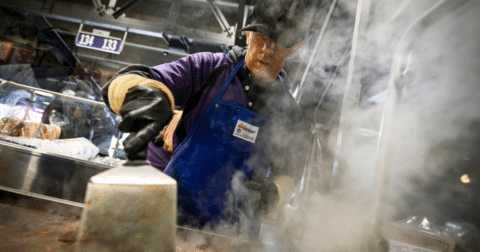Explainer
How Overconsumption Affects the Environment and Health, Explained
Climate•12 min read
News
Beef prices are at a record high, but that doesn’t mean less meat production.


Words by Seth Millstein
Grillers and carnivores beware: Beef prices in America are at an all-time high. Given how much climate pollution cattle farms produce, you might think this is a positive environmental development, with higher prices resulting in people eating less beef. Unfortunately, that’s not the case — and in fact, pricier beef might actually increase greenhouse gas emissions from beef production, which are already quite substantial.
The price of beef has increased nine percent since the beginning of the year, according to the USDA. Steak and ground beef prices have risen by 12 and 10 percent, respectively, from a year earlier, and the head of Tyson foods recently said on a conference call that “beef is experiencing the most challenging market conditions we have ever seen.”
But Americans haven’t reacted to this price bump by eating less beef. Instead, they’re eating more imported beef — which is a problem for the environment, as cattle farms abroad are significantly less carbon-efficient than they are in America.
“America is very efficient at beef production,” Alison Van Eenennaam, professor and cooperative extension specialist in the Department of Animal Science at the University of California, Davis, tells Sentient. “If you’re importing from countries that are less efficient, then you’re actually increasing your footprint.”
Beef’s high price is a result of supply-and-demand: The overall supply of beef in the U.S. has gone down, but consumer demand has stayed the same.
On the supply side, America’s cattle herds have been shrinking. As of January, there were fewer beef cows in the U.S. than at any point since 1961, according to an analysis of USDA data. Although there’s no one reason for this, there appear to be two primary causes.
First, much of the U.S. faced a drought for much of 2020-2023. This made it more difficult to grow the plants and food that are used to feed cattle; as a result, cattle feed prices rose during that time, and many cattle farmers opted to either reduce or simply not increase their herd size in response to what was effectively an increase in their input costs.
Although drought is a naturally occurring phenomenon, it’s also exacerbated by global warming. This is relevant because beef production itself is a significant driver of global warming, due to the massive amounts of land used for feed crops and pasture, as well as the methane cattle emit as part of their digestive process.
On top of these, beef is a leading driver of deforestation, which comes with what is called a climate opportunity cost — that is, when you deforest land, there are a bunch of emissions released then, but you also lose out on the opportunity to store carbon in the ground without that forest or other wild landscape. That additional cost is yet another reason why beef is especially damaging for climate change.
All of this is as ironic as it is unsustainable: The process of raising cattle for beef is, itself, making it more difficult to raise cattle for beef.
In response to these high feed costs, many cattle farmers sold their breeding cows as beef, as this was cheaper than continuing to breed and feed them. But because it takes years for cows to grow large enough to be slaughtered for beef, this reduction in breeding cows several years ago has contributed to the low numbers of beef cattle in the U.S. today.
The cattle industry was also hit by an outbreak of New World screwworm in Mexico earlier in the year. The screwworm is a parasitic fly that infects and kills cattle, and in an attempt to prevent the insect from reaching the U.S., the USDA halted all cattle imports from Mexico in May. The U.S. imports over a million cows from Mexico every year, so this moratorium reduced the overall supply of cattle and beef.
You might think that, with beef becoming more expensive than it’s ever been, Americans would start eating less of it. But you’d be wrong.
“Beef consumption in the U.S. is what’s called very inelastic,” Jerome Dumortier, professor of agricultural economics and policy at Indiana University Indianapolis, tells Sentient. “Even if prices increase — and we do see an increase in beef prices right now — there is not really a decline in the demand.”
In other words, Americans love their beef, and will keep eating it even when doing so breaks the bank. This is especially true in the summer, when warm weather and Fourth of July celebrations lead to millions of Americans cooking burgers in their backyards. This increase in summertime demand for meat is expected, but it’s also played a role in higher prices this year amidst the shortage in beef supply.
It will be a while until we know for certain what impact today’s high beef prices have on carbon emissions. But there’s a good chance that the dip in America’s cattle supply will actually lead to an increase in greenhouse gasses. This is due to the complex relationship between the international beef trade, consumer preferences and differences in beef production methods around the world.
Although beef prices are high in general, not all beef costs the same; uncooked ground beef goes for about half the price of a sirloin steak, for instance. Given that beef prices have risen across the board, it would make sense for consumers to begin purchasing cheaper cuts of beef instead, and the massive increase in beef imports over the last year suggests that this is the case.
In general, the U.S. imports what would be considered low-quality beef — specifically, the trimmings that are used to make burgers — while exporting higher-quality cuts, like steak. This means that when Americans start eating more ground beef and less steak, a higher share of consumed beef in the U.S. is coming from overseas.
This is a problem, Dumortier says, because beef production in other countries emits a lot more greenhouse gasses than it does in the United States.
“The U.S. is very efficient at producing low-emission beef,” Dumortier says. “The emissions are very high, yes, but they are still lower compared to other countries for the same amount of meat.”
To be clear, beef production is highly destructive to the environment regardless of how or where it’s made. When compared with other proteins, plant and animal alike, it emits more greenhouse gasses on a per-gram basis than any other food.
That said, in a 2021 paper, Dumortier and a co-researcher found that American cattle farms emit less greenhouse gasses per pound of beef produced than all of the top beef exporters to the U.S., including Mexico, China, Brazil, Canada and Australia.
There are a number of reasons why the U.S. is so efficient in this regard, Dumortier says, as everything from the weight of the cows to the weather will impact how much a cattle farm emits.
Van Eenennaam says that the difference between America and the other countries in this realm largely comes down to different production methods, and the type of food the cows are eating.
On factory farms, where most U.S. beef is produced, cows spend the final 160 to 180 days of their lives eating grain-based feed instead of grass. This helps cattle reach market weight more quickly than grass-fed cattle, which means they spend fewer total days emitting methane. In contrast, in countries with less intensive agricultural systems, cows subsist on grass for their entire lives, emitting methane over a longer period.
“The more technology and intensification that a country has brought to the table, the lower the emissions per kilogram of product,” Van Eenennaam says. “The highest emissions tend to be very low production systems that are run 100 percent on cellulose, or feed out on the range.”
There’s another reason that beef production is often much more greenhouse-intensive abroad than in the U.S., and that’s deforestation. Around 11 percent of global greenhouse emissions are the result of deforestation, and beef production is the leading driver of deforestation worldwide, as millions of hectares of trees are cleared to build cattle farms.
Although a small amount of this occurs in the U.S., 95 percent of global deforestation takes place in the tropics. The country responsible for the most deforestation is Brazil, which also happens to be the biggest beef exporter in the world and a major importer to the U.S. specifically. The second-biggest beef exporter is India, which is also a deforestation hotspot.
When Americans replace domestically-produced beef with imported beef, a good chunk of that new beef will be the product of deforestation.
Ultimately, it’s not at all clear if and when beef prices will fall. In fact, they might even climb higher: On July 30, President Trump enacted a 50 percent tariff on Brazilian imports to the U.S., and Brazil is responsible for around 23 percent of all U.S. beef imports.
Record-high beef prices could be an opportunity for consumers in the U.S. who eat four times more than the global average to cut back on beef and opt for a lighter environmental footprint. But for now, Americans are still eating just as much beef — they’re just getting more of it from overseas. And because foreign beef production is less efficient from an emissions standpoint, those high prices aren’t helping the planet. So far, the shift is making things worse.